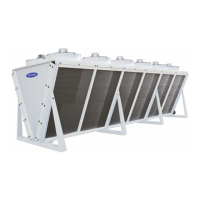CHECK
■ For fans tted with straps:
- Perform a visual inspection of the ground straps (check they are present) and check that the ground strap terminal retaining
screws are correctly tightened.
- With the fan switched off, measure the resistance between one ground strap terminal on the intake section and the connection
terminal to the customer ground with a supply of 12 Volts. During the rst check, this measurement must be noted on the
maintenance sheet (see section 26 - Appendix, next page) as well as the reference resistance. The resistance must not exceed
25% of the reference resistance.
■ If the resistance check exceeds 25% of the reference resistance:
- Dismantle each ground strap terminal individually. Only one terminal must be disconnected at a time (this operation must be
performed with the fan switched off).
- Check that there is no area of pitting corrosion on the grounding lug or strap terminal.
- Repeat the resistance measurement.
FREQUENCY OF CHECK
■ Elements ensuring ground continuity must be checked at the following intervals:
- Every 150 hours, or weekly, during the rst month of installation.
■ If any irregularity is detected during this period of observation:
- Every 5000 hours, or annually thereafter.
CORRECTIVE ACTIONS
In the following cases:
■ Ground strap terminal retaining screws incorrectly tightened:
- Retighten the screws, if the problem persists.
■ Areas of pitting corrosion detected on the grounding lug
- Lightly grind the surface of the lug and carefully check the condition of the ground strap terminal.
■ Areas of pitting corrosion detected on the ground strap
- Replace the ground strap.
19.3 - Using tools in an explosive atmosphere
The operating managers for the installations and processes which include explosive atmospheres must provide all persons working
on a site with information relating to using manual tools in complete safety. There are two different types to be taken into consideration:
- Type A: Tools liable to only produce single sparks when used, such as screwdrivers, spanners or impacts wrenches, for example;
- Type B: Tools that generate a plume of sparks, which may be used during grinding or sawing operations.
In zones 1 and 2, only type A tools are permitted; use of type B tools can only be authorised if no dangerous explosive atmosphere is
present within the working area.
In zone 1, and in the presence of substances belonging to group IIC (acetylene, carbon disulphide, hydrogen) and hydrogen sulphide,
ethylene oxide, carbon monoxide, if there is a risk of explosion due to the presence of these substances, the use of steel tools is
prohibited unless it can be assured that no dangerous explosive atmosphere remains in the place of work whilst these tools are being
used.
The use of tools in zones 1 and 2 must be subject to the "work permit" system.
All other types of tools or equipment required for maintenance operations (vacuum cleaners, etc) must be compatible with use in the
ATEX zone in question. Otherwise, it must be ensured that, prior to and for the duration of any maintenance operation,
the place of work is sufciently ventilated to prevent the presence or formation of an explosive atmosphere.
19 - SPECIAL INFORMATION FOR ATEX AREAS
25

